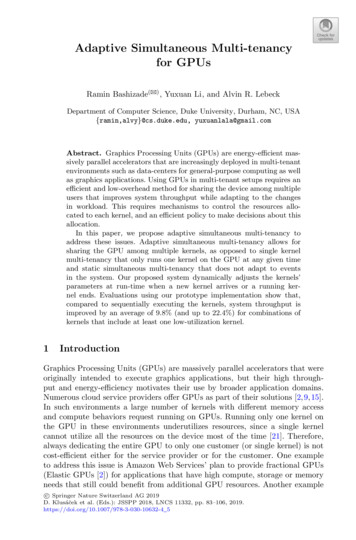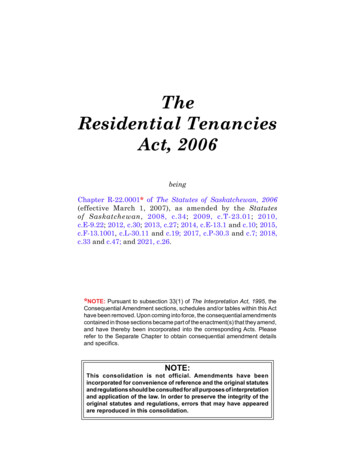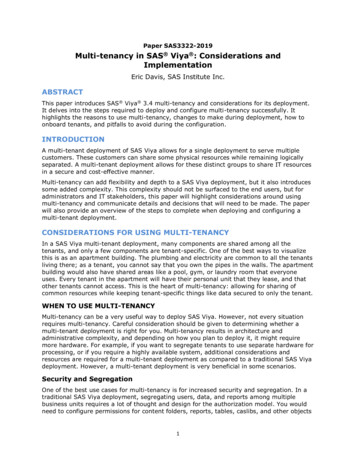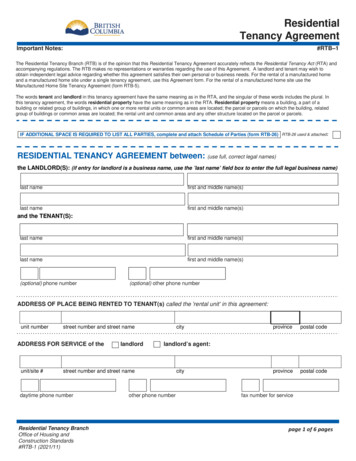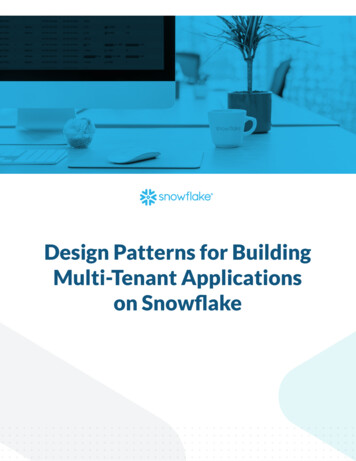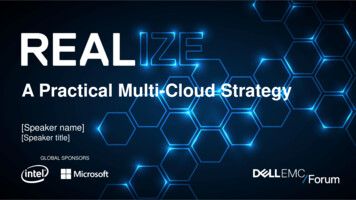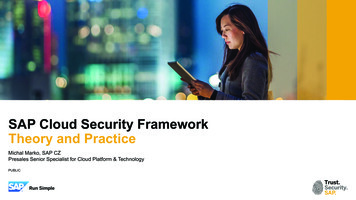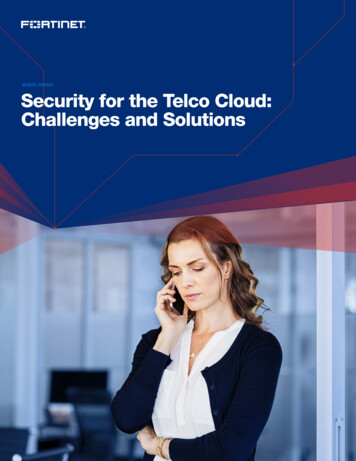
Transcription
DEGREE PROJECT IN INFORMATION ANDCOMMUNICATION TECHNOLOGY,SECOND CYCLE, 30 CREDITSSTOCKHOLM, SWEDEN 2019Multi-Tenancy Securityin Cloud ComputingEdge Computing and Distributed CloudALI SHOKROLLAHI YANCHESHMEHKTH ROYAL INSTITUTE OF TECHNOLOGYSCHOOL OF ELECTRICAL ENGINEERING AND COMPUTER SCIENCE
Multi-Tenancy Security in CloudComputingAli Shokrollahi YancheshmehMaster of Science ThesisCommunication SystemsSchool of Electrical Engineering and Computer ScienceKTH Royal Institute of TechnologyExaminer: Peter SjödinSupervisor: Markus HidellEricssonSupervisor: Christopher PriceStockholm, SwedenDec 2019
AbstractWith the advent of technology cloud computing has become the next generation ofnetwork computing where cloud computing can deliver both software and hardwareas on-demand services over the Internet. Cloud computing has enabled smallorganizations to build web and mobile apps for millions of users by utilizing theconcept of “pay-as-you-go” for applications, computing, network and storageresources as on-demand services. These services can be provided to the tenants indifferent categories: Infrastructure as a Service (IaaS), Platform as a Service (PaaS)and Software as a Service (SaaS). In order to decrease the costs for the cloud usersand increase resource utilization, cloud providers try to share the resources betweendifferent organizations (tenants) through a shared environment which is calledMulti-Tenancy.Even though multi-tenancy‟s benefits are tremendous for both cloud providers andusers, security and privacy concerns are the primary obstacles to Multi-Tenancy.Since Multi-Tenancy dramatically depends on resource sharing, many experts havesuggested different approaches to secure Multi-Tenancy. One of the solutions isresource allocation and isolation techniques. In most cases, resource allocationtechniques consider but are not sufficient for security. OpenStack community uses amethod to isolate the resources in a Multi-Tenant environment. Even though thismethod is based on a smart filtering technique to segregate the resources in Computenodes (the component that the instances are running on it in OpenStack), thismethod is not flawless. The problem comes up in the Cinder nodes where theresources are not isolated. This failure can be considered as a security concern for aMulti-Tenant environment in OpenStack.In order to solve this problem, this project explores a method to secure MultiTenancy for both sides in the Compute node and for backend where Block Storagedevices for the instances can be isolated as well.KeywordsCloud computing, OpenStack, Multi-Tenancy, Security, Multi-Tenancy Isolation.
SammanfattningMed tillkomsten av teknik har molnberäkning blivit nästa generationnätverksberäkning där molnberäkning kan leverera både mjukvara och hårdvarasom on-demand-tjänster över Internet. Cloud computing har gjort det möjligt försmå organisationer att bygga webb- och mobilappar för miljontals användare genomatt använda begreppet ”pay-as-you-go” för applikationer, datoranläggningar,nätverks- och lagringsresurser som on-demand-tjänster. Dessa tjänster kantillhandahållas hyresgästerna i olika kategorier: Infrastructure as a Service (IaaS),Platform as a Service (PaaS) och Software as a Service (SaaS). För att minskakostnaderna för molnanvändarna och öka resursanvändningen, försökermolnleverantörer att dela resurserna mellan olika organisationer (hyresgäster)genom en delad miljö som kallas Multi-Tenancy.Men fördelarna med flera hyresgäster är enorma för både molnleverantörer ochanvändare, säkerhets- och integritetsfrågor är de främsta hindren för Multi-Tenancy.Eftersom Multi-Tenancy dramatiskt beror på resursdelning har många experterföreslagit olika metoder för att säkra Multi-Tenancy. En av lösningarna ärresursallokering och isoleringstekniker. I de flesta fall beaktarresursallokeringstekniker men är inte tillräckliga för säkerhet. OpenStackcommunity använder en metod för att isolera resurserna i en Multi-Tenant-miljö.Men denna metod är baserad på en smart filtreringsteknik för att separeraresurserna i Compute-noder (komponenten som instansen körs på den i OpenStack),den här metoden är inte felfri. Problemet kommer upp i Cinder-noderna därresurserna inte är isolerade. Detta fel kan betraktas som ett säkerhetsproblem för enMulti-Tenant-miljö i OpenStack.För att lösa detta problem försöker detta projekt säkra Multi-Tenancy för båda sidor iCompute-noden och för backend där Block Storage-enheter för instanserna ocksåkan isoleras.KeywordsCloud computing, OpenStack, Multi-Tenancy, Security, Multi-Tenancy Isolation.
Contents1Introduction . 11.1Background .21.2Problem .31.3Purpose .41.4Goal .41.4.1 Benefits, Ethics and Sustainability . 51.5Methodology and Methods . 51.6Delimitations . 51.7Outline .62Background . 82.1Cloud Computing . 82.1.1 Essential characteristics .92.1.2 Deployment models .92.1.3 Service models . 112.2 OpenStack . 152.2.1 OpenStack Architecture . 212.3Problem Statement . 232.3.1 Multi-Tenancy in Cloud Computing . 232.3.2 Multi-Tenancy Security Issues in Cloud Computing. 252.4 Related Work .272.4.1 Resource Isolation . 282.4.2 IDS & IPS . 292.4.3 Summary . 293Methodology and Method. 31
3.1 Research process . 313.2 Data Collection . 323.3 Experimental Design . 323.3.1 Hardware Platform . 323.3.2 Software Platform. 323.4 Reliability and Validity . 323.4.1 Reliability . 333.4.2 Validity . 334Multi-Tenancy Isolation in OpenStack . 354.1 Resource Isolation in OpenStack . 354.2 Resource Isolation goals . 364.3 Resource Isolation Problems and Challenges in OpenStack .374.4 Resource Isolation in OpenStack Implementation . 38Host Aggregates and Availability Zones . 385Results and Analysis . 455.1Major results . 455.1.1 IDS & IPS vs. Multi-Tenancy Isolation . 455.1.2 Multi-Tenancy Isolation for Compute nodes and Backend(s) . 465.3Reliability Analysis . 505.4Validity Analysis . 505.5Discussion . 505.5.1 Cost Saving . 515.5.2 Security and Privacy . 516Conclusions and Future work . 536.1Conclusions . 536.2Limitations . 546.3Future Work . 54
6.4 Reflections . 54References. . 57Appendix A. . 62Appendix B. . 69Ansible. . 69Ansible Playbook for Multi–Tenancy Resource Isolation . 70
List of FiguresFigure 2-1: cloud computing definition [17] . 8Figure 2-2: Cloud Computing Services [13] . 12Figure 2-3: Layered cloud computing models and examples [16] . 14Figure 2-4: OpenStack general view [18] . 16Figure 2-5: Different Hosts in OpenStack [20], [21] . 17Figure 2-6: OpenStack Conceptual Architecture [19] . 19Figure 2-7: OpenStack with Three-Node Configuration Architecture [23] . 22Figure 2-8: Benefits of Multi-Tenancy tree [1] . 24Figure 2-9: Difference between Multi-Tenancy and other networks [1] . 26Figure 3-1: Research process steps . 31Figure 4-1: Resource Isolation in OpenStack by OpenStack Community [30] . 36Figure 4-2: Host Aggregates [31] . 39Figure 4-3: Nova scheduler filter [24], [33]. 40Figure 4-4: Multi-Tenancy Isolation [29], [30] . 42Figure A-1: OpenStack in OPNFV Server . 62Figure B-1: Ansible Scheme [44]. 69
List of TablesTable 5.1: Resource Isolation in Compute node and Block Storage .47Table 5.2: Comparison between different methods for Resource Isolation . 49Table 5.3: Comparison between IDS & IPS and Full Resource Isolation. 50
List of Acronyms and AbbreviationsThis document requires readers to be familiar with certain terms and concepts.For clarity, we summarize some of these terms and give a short description of thembefore presenting them in the next sections.IaaSInfrastructure as a ServicePaaSPlatform as a ServiceSaaSSoftware as a ServiceCSPCloud Service ProviderIDSIntrusion Detection SystemIPSIntrusion Prevention SystemLXCLinux ContainersTaaSTap as a ServiceLOMLight Out ManagementIPMIIntelligent Platform Management InterfaceKVMKernel-based Virtual MachineC-GroupsControl GroupsNATNetwork Address TranslationNTPNetwork Time ProtocolSOAService-Oriented ArchitectureCSACloud Security AllianceAOPAspect-Oriented ProgrammingOPNFVOpen Platform for NFV ProjectNISTNational Institute of Standards and TechnologyMTCEMMulti-Tenant Trusted Computing Environment
1 IntroductionCloud computing is known as one of the most popular and widely exploitedtechnologies that gives this opportunity to all small and big enterprises to accesssystem resources via the internet. A wide range of users‟ needs such as data storage,processor power, and software via outside sources with the concepts of pay-per-use isfulfilled by Cloud Computing. It means customers (users) can use the resources aslong as they pay for it as a tenant. Cloud computing brings great advantages forcustomers such as high flexibility and performance without requiring complicatedmaintenance tasks [27]. In order to take full advantage of cloud computing, MultiTenant architecture is designed with the goal of maximizing resource sharing amongusers. Not only Multi-Tenancy provides full resource utilization for the cloudproviders, but also it decreases the cost for the clients. Multi-Tenancy can bedescribed as an architectural structure that allows all resources to be shared bymultiple users and sub-users at the same time [27].Even though Multi-Tenancy brings many advantages both for service providers andcustomers, it is not flawless and it has its own security issues. Multi-Tenancy securityissues are related to integrity and confidentiality risks in sharing resources in cloudcomputing. When multiple users are sharing the same resources, a malicious usercan take the advantage to get access to all other users‟ resources by using some tricks[1].Network security experts suggest different solutions to overcome Multi-Tenancysecurity issues. Some suggest using resource allocation techniques due to the natureof Multi-Tenancy [27]. Other security experts, on the other hand, are of the opinionthat automated security control can be the best option for cloud providers to protecttheir network from malicious users. They offer Intrusion Detection System [10].Host-based IDS and Network-based IDS are two types of IDS that can be deployed ina cloud environment.However, for a Multi-Tenant environment, Network-based IDS cannot be usefulsince it can only address attacks from outsiders, not insiders [28]. Host-based IDScan be useful for checking inside attacks where both attackers and victims are located1
in the same place. In order to solve this problem and avoid imposing security tasks tothe customers, this project explores a method for isolating the tenants in a sharedenvironment and shows the importance of the automation of that method wherethere are lots of users and nodes.In the following, first, this report provides a general background of different aspectsand areas such as problems, goals, and purpose of this thesis and its benefits andadvantages. In the second chapter, all the urgent information will be provided indetail with graphs and figures. Chapter three describes the method and methodologywhich gives information about solving the problem and the utilized methods.Chapter four describes the implementation of the project, and it depicts the fullresource isolation in OpenStack for a Multi-Tenant environment. Finally, in Chapterfive and six results and conclusion will be shown. This project is ended up with twoappendix parts in order to give technical details of the implementation.1.1 BackgroundCloud computing is an urgent need in the IT industry these days that it makesorganizations needless of running data centers to run their applications withoutpaying the high expenditure for buying or maintaining the hardware. Cloudcomputing can be deployed on four different types based on different needs: Public,Private, Community and Hybrid Cloud. Public cloud such as Amazon Web Services(AWS), Google Cloud Platform that are provided for general usage, Private Cloudthat can be used for a single company, Community Cloud that is used by a group ofusers (companies) or Hybrid Cloud that can be a mix of other three models [17].In addition the deployment models, Cloud Computing can be provided with differentservices; in Software as a Service (SaaS), cloud providers share software orapplication to multiple users over the internet different applications such as GoogleApps can be an example for SaaS. In Platform as a Service (PaaS), a virtualizedenvironment (platform) will be dedicated to developers (users), and a user can runits own applications on that virtualized environment. Google Apps Engine is one ofthe best examples for PaaS, Finally, in Infrastructure as a Service (IaaS), a pool ofresources such as servers, routers, storage and switches are dedicated to a user. Theuser has the ability to compute, storing and network resourcing, and he can controlthese resources without managing the infrastructures.2
OpenStack is one of the most famous IaaS providers [15]. OpenStack is an opensource cloud computing platform to implement Infrastructure as a Service with highscalability for public and private clouds. OpenStack controls computing, storage andnetworking resources throughout a data center. All the management andprovisioning are through APIs with a common authentication mechanism [18], [19].This project uses OpenStack as a cloud provider where all the resources areestablished in three nodes as the jump host, controller and compute nodes. Aspreviously mentioned, in order to decrease the cost for users and full resourceutilization, cloud providers share the dedicated resources between multiple users.For example in this project OpenStack is used as the cloud provider with a Computenode. Compute node runs VMs as the instances and every single VM or computenode can be shared between multiple users. To provide security between the users ina shared compute node the best way that is suggested by many security experts isusing the resource allocation technique before running any instances by user [27],[29], [33].As an example in a private cloud, just imagine an organization that has two differentdepartments (A, B) where they are assigned to different tenants (projects). Theproblem arises when the application that is used by department A needs to be totallysegregated from everyone else even department B. Therefore, Multi-Tenant Isolationcan meet the security concerns instead of creating a cloud region for everydepartment.1.2 ProblemMulti-Tenancy has pros and cons; form one side it increases resource utilization anddecreases the costs, but from the other side, it brings security and privacy concerns[1]. In a Multi-Tenant environment, users are separated from each other at thevirtual level, but the hardware is not isolated and users share the hardware [3]. Somesecurity specialists believe in using smart techniques for resource isolation andseparation the tenants from each other to overcome security issues in Multi-Tenancy;The reason is to increase the security in Multi-Tenancy with doing resourceallocation and make it harder and more costly for the attackers to investigate thenetwork [1], [10].3
As mentioned above, cloud computing can provide different services and in everyservice, Multi-Tenancy implies a different meaning. In IaaS, where this project usesthe OpenStack as a cloud provider, just using resource utilization from the computenodes cannot meet the security concerns because of using the same physical serversfor the storage. So should have been omitted Multi-Tenancy due to the security flawsin the backend?This project aims to answer that question.Wayne Brown et al suggest the best precaution for making hypervisor and in general,IaaS secure and preventing attacks is maintaining and updating hypervisor softwareand implementing Intrusion Detection and Prevention System to have a permanentobservation of the cloud environment [10]. Other perimeter security controls, likefirewalls can be used as well, but due to the shared Multi-Tenancy nature of cloudcomputing it might be less effective. In OpenStack, it is possible to use two kinds ofIDS, Network-based IDS, and Host-based IDS. NIDS tries to address attacks fromoutsiders and it has limited effectiveness against insider attacks.HIDS can be effective but typically must be monitored and managed by the cloudusers and every single user may use multiple shared instances [28]. The nextquestion is, should we impose the security tasks to amateur users and ask them tosecure the dedicated resources?1.3 PurposeThe purpose of this project is to solve the security issues in Multi-Tenancy in cloudcomputing and avoid to burden users with security measurements. This project aimsto bring one layer of security and privacy via dedicating a set group of Compute andCinder nodes to a particular tenant and prevent the possibility of having maliciousneighbors.1.4 GoalThe goal of this project is to bring security for Multi-Tenancy via an isolation methodfor both sides in OpenStack; in compute nodes where the users want to lunch aninstance, and for the backend where a volume (Block Storage) wants to attach to thatinstance to enable persistent storage.4
1.4.1 Benefits, Ethics and SustainabilityThis project plans to conserve Multi-Tenancy as one of the best properties of cloudcomputing in a secure way that users are not concerned about the privacy andsecurity issues of a Multi-Tenant environment. Even though it imposes morecomplex configurations for the cloud service providers, it brings an automationmethod for doing the entire configuration with Ansible playbook. This paper not onlymeets the security requirements for both users and providers, but also decreases thecosts for the users and increases the hardware utilization for providers through asecure Multi-Tenant area.1.5 Methodology and MethodsThe methodology that is used in this project will be qualitative research with themain work being an extensive literature study followed by a case study of theimplementation at Ericsson. Moreover, research will be inductive where it uses [10]and [1] as facts and best practices for increasing the security in Multi-Tenancy byusing isolation. The analysis will be qualitative to understand what needs to be donein order to validate the solution. The reason for selecting the qualitative methodinstead of quantitative is to find a suitable way to measure the effectiveness ofisolation in both computing and storage instead of just isolation for computing.1.6 DelimitationsThis project mainly focuses on theoretical and practical implications for securityissues in Multi-Tenancy in cloud computing where running automation of resourceallocation can be the best solution to overcome the security issues of multi-tenancy inOpenStack. This project uses a cloud environment provided by OPNFV which isinstalled on bare-metal to implement OpenStack as IaaS. The architecture of OPNFVcloud is based on three nodes where one node is using the jump host for running theOpenStack commands, one node as the controller for running the most importantservices of OpenStack, such Horizon (web interface), Keystone, and Neutron;Compute node, where the instances are running on the hypervisor and Cinder as theOpenStack Block Storage service (Cinder is a software designed to create and managea service that provides persistent data storage). This cloud environment is just usingVirtual Machines and it doesn‟t consist of Nova Container Node for running thecontainers.5
All those services are running in the LXC (Linux Containers), and in order to run theisolation method, the OpenStack features are enabled. It means that for allocatingthe compute nodes to the users, nova-scheduler filters are used [33]. For thebackend, Cinder multi backend is enabled [34].1.7 OutlineIn the following, the Background section will describe all the essential requirementsfor the thesis where detailed information about cloud computing, OpenStack, multitenancy, security issues in Multi-Tenancy and Resource Isolation in OpenStack willbe denoted.6
7
2 BackgroundThis chapter provides basic and detailed information about cloud computing,OpenStack, Multi-Tenancy in cloud computing. Additionally, this chapter describessecurity issues in Multi-Tenancy in cloud computing as the problem statement andits related works.2.1 Cloud ComputingAccording to the National Institute of Standards and Technology (NIST), “Cloudcomputing is a model for enabling ubiquitous, convenient, on-demand networkaccess to a shared pool of configurable computing resources (e.g., networks, servers,storage, applications, and services) that can be rapidly provisioned and released withminimal management effort or service provider interaction” [14]. The cloud modelconsists of five essential characteristics, three service models, and four deploymentmodels; you can see the general cloud architecture in Figure 2.1.Figure 2-1: cloud computing definition [17]8
2.1.1 Essential characteristicsOn-demand self-service: The user can prepare computing features andcapabilities on a one-way demand and automatically without human interaction inthe middle [14].Broad network access: features are ready to use, all entire network throughstandard mechanisms that rise via user‟s platforms such as laptops, mobiles, andtablets [14].Resource pooling: The resources can be shared between multiple users in a MultiTenant model where according to the user‟s demand different physical and virtualresources can be shared between. The resources (such as storage and memory,network bandwidth, processors) can be dedicated to the users without any control orinformation about the resource location and resource equipment even though it maypossible for the users to know about the location of the resources on a higher levelsuch as country or location of the data center [14].Rapid elasticity: the released capabilities should be flexible and automated to scalethe demands quickly. In other words, the capabilities should be available at any timeand any quantity [14].Measured service: Cloud providers are the authority for control and optimizingthe resources by using some metrics such as pay-per-use or charge-per-use accordingto the type of service. Moreover, resource usage and utilized services can bemonitored and reported to both providers and consumers [14].2.1.2 Deployment modelsPublic cloud: In this model, the cloud is provided for open and public utilizationand it can be owned, managed and controlled by a company, university, governmentor a mix of them. In other words, Public clouds are available to general use and areowned by a third-party who offers the services. Third-parties store the data that iscreated and submitted by the users on the server [14]. In Public Cloud, resources areprovided as a service to consumers via the internet (pay-per-usage-fee). There is noneed for users to buy expensive hardware, and they can scale their usage on a9
demand. The most important advantages of Public cloud are scalability, availabilityall the time. Talking about its shortcomings, security and privacy can be considered.Reliability is one of the concerns about Public clouds, and it arises with the unknowndata‟s location or the method that is used for storing data or the accessibility of data.Public Cloud‟s structure doesn‟t meet the specific organization‟s privacy and securityconcerns, so an organization needs to find out “is the selected Public cloud providerable to meet its security and privacy concerns” or not. The examples of Public cloudinclude Amazon Web Service (AWS), Microsoft Azure and Google Cloud Platform[15].Private cloud: the private cloud is provided for a single enterprise or organizationexclusively where multiple consumers can have access to the resources. A privatecloud can be owned or managed by an organization or a third-party or both [14]. Aprivate cloud is located in a data center of an organization or a company and onlyprovides the services to the users inside the company. In comparison with the PublicCloud, Private c
network computing where cloud computing can deliver both software and hardware as on-demand services over the Internet. Cloud computing has enabled small organizations to build web and mobile apps for millions of users by utilizing the concept of "pay-as-you-go" for applications, computing, network and storage resources as on-demand services.
